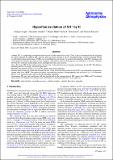Por favor, use este identificador para citar o enlazar a este item:
http://hdl.handle.net/10261/224407COMPARTIR / EXPORTAR:
 SHARE SHARE
 CORE
BASE CORE
BASE
|
|
| Visualizar otros formatos: MARC | Dublin Core | RDF | ORE | MODS | METS | DIDL | DATACITE | |

| Título: | Hyperfine excitation of SH+by H |
Autor: | Lique, François; Zanchet, Alexandre CSIC ORCID; Bulut, N.; Goicoechea, Javier R. CSIC ORCID; Roncero, Octavio CSIC ORCID | Palabras clave: | Molecular data Molecular processes Radiative transfer Methods: laboratory: molecular |
Fecha de publicación: | 12-jun-2020 | Editor: | Springer Nature | Citación: | Astronomy and Astrophysics 638: A72 (2020) | Resumen: | Context. SH+ is a surprisingly widespread molecular ion in diffuse interstellar clouds. There, it plays an important role by triggering the sulfur chemistry. In addition, SH+ emission lines have been detected at the UV-illuminated edges of dense molecular clouds, so-called photo-dissociation regions (PDRs), and toward high-mass protostars. An accurate determination of the SH+ abundance and of the physical conditions prevailing in these energetic environments relies on knowing the rate coefficients of inelastic collisions between SH+ molecules and hydrogen atoms, hydrogen molecules, and electrons. Aims. We derive SH+-H fine and hyperfine-resolved rate coefficients from recent quantum calculations for the SH+-H collisions, including inelastic, exchange, and reactive processes. Methods. The method we used is based on the infinite-order sudden approach. Results. State-to-state rate coefficients between the first 31 fine levels and 61 hyperfine levels of SH+ were obtained for temperatures ranging from 10 to 1000 K. Fine-structure resolved rate coefficients present a strong propensity rule in favor of Δj = ΔN transitions. The Δj = ΔF propensity rule is observed for the hyperfine transitions. Conclusions. The new rate coefficients will help significantly in the interpretation of SH+ spectra from PDRs and UV-irradiated shocks where the abundance of hydrogen atoms with respect to hydrogen molecules can be significant. | Descripción: | 5 pags., 3 figs. | Versión del editor: | http://dx.doi.org/10.1051/0004-6361/202038041 | URI: | http://hdl.handle.net/10261/224407 | DOI: | 10.1051/0004-6361/202038041 | Identificadores: | doi: 10.1051/0004-6361/202038041 issn: 1432-0746 |
| Aparece en las colecciones: | (CFMAC-IFF) Artículos |
Ficheros en este ítem:
| Fichero | Descripción | Tamaño | Formato | |
|---|---|---|---|---|
| Hyperfine excitation.pdf | 215,77 kB | Adobe PDF |  Visualizar/Abrir |
CORE Recommender
SCOPUSTM
Citations
8
checked on 25-abr-2024
WEB OF SCIENCETM
Citations
6
checked on 25-feb-2024
Page view(s)
63
checked on 29-abr-2024
Download(s)
84
checked on 29-abr-2024
Google ScholarTM
Check
Altmetric
Altmetric
NOTA: Los ítems de Digital.CSIC están protegidos por copyright, con todos los derechos reservados, a menos que se indique lo contrario.
